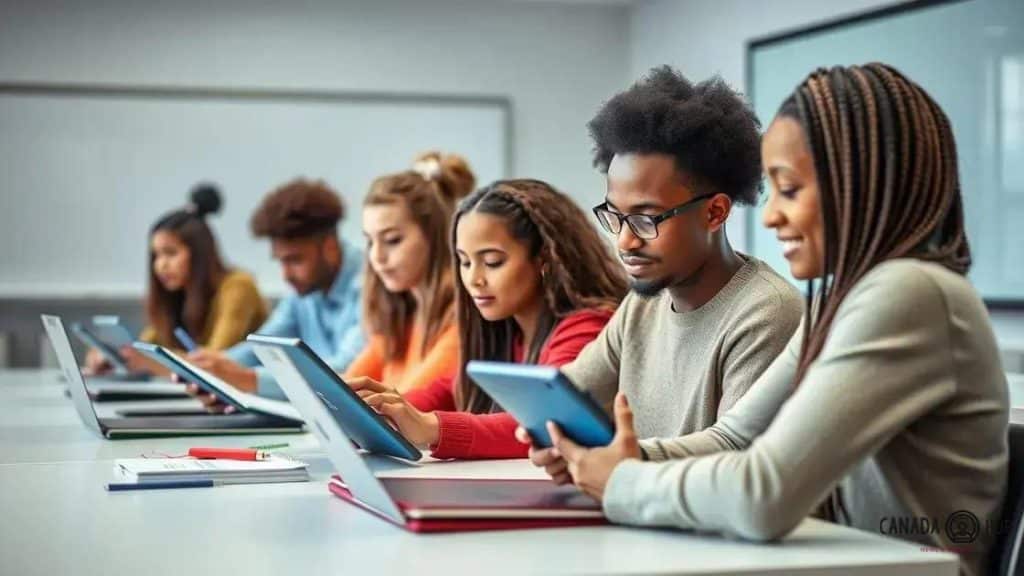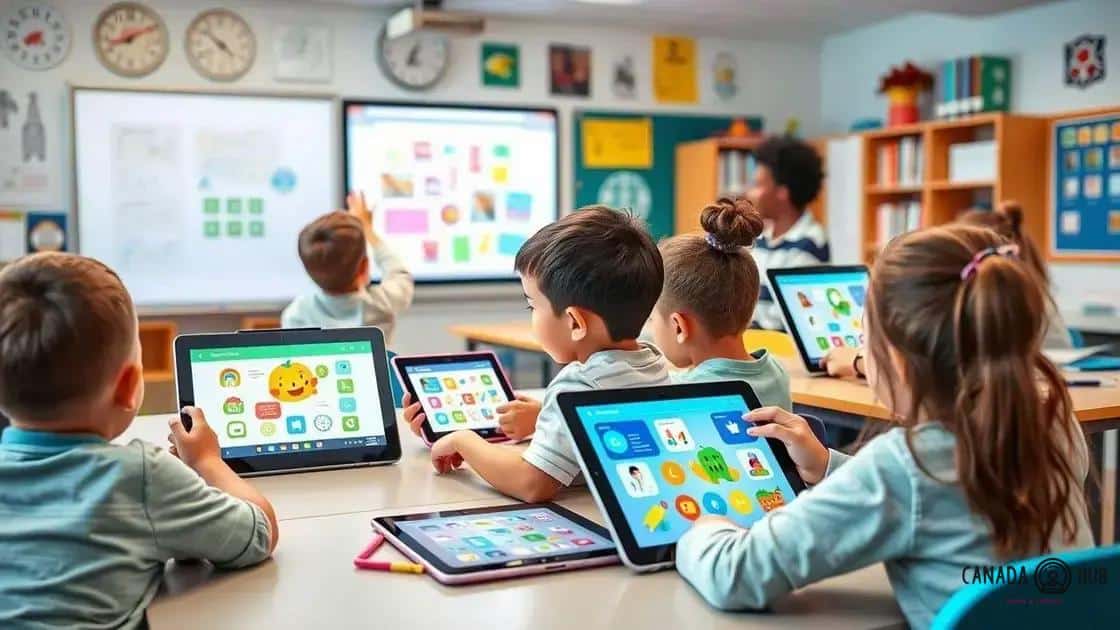Technology investments in classroom learning tools benefit students

Technology investments in classroom learning tools enhance student engagement, personalize learning experiences, and provide interactive educational environments, making education more effective and aligned with the needs of modern learners.
Technology investments in classroom learning tools are reshaping how students learn and teachers instruct. Have you ever wondered how these innovations can create a more engaging learning environment? Let’s dive into the transformative benefits they offer.
Why technology investments matter in education
Understanding why technology investments matter in education is crucial for schools aiming to improve learning environments. The right tools can significantly engage students and enhance their learning experiences.
Boosting Student Engagement
When technology is integrated into the classroom, it often boosts student engagement. Interactive tools, like smartboards and educational apps, make lessons more interactive. Students are more likely to participate when they feel engaged.
Enhancing Learning Outcomes
Investing in the right technology can lead to better learning outcomes. Research shows that students who use technology effectively can demonstrate improved understanding of complex concepts.
- Access to diverse resources
- Personalized learning experiences
- Immediate feedback for students
Moreover, technology helps cater to different learning styles. Some students learn better through visuals while others prefer hands-on activities. Technology allows for this variety.
Preparing for the Future
Investments in technology also prepare students for the skills they need in the future. The world is becoming increasingly digital, and having experience with technology gives students a competitive edge.
Additionally, technology in education fosters collaboration among students, helping them to develop skills necessary for teamwork in the workplace.
- Team projects using digital platforms
- Communication tools for group work
- Encouraging peer-to-peer learning
In summary, valuing technology investments in education leads to enriched experiences that are essential for today’s learners. Schools must embrace these tools to create an impactful educational experience.
Top tools for classroom learning

When it comes to enhancing classroom learning, selecting the right tools is essential. The following tools are proven to facilitate effective teaching and engage students in new ways.
Interactive Whiteboards
Interactive whiteboards allow teachers to display lessons visually. They promote interactive learning, enabling teachers to involve students in activities. Students can write, draw, and collaborate directly on the board, making lessons more dynamic.
Learning Management Systems (LMS)
A Learning Management System is a software that helps organize and deliver educational courses. It allows for easy assignment distribution, grading, and tracking student progress. Popular LMS platforms like Google Classroom and Moodle provide a central hub for resources and communication.
- Tracks student performance
- Facilitates communication between students and teachers
- Offers resources and materials in one place
Additionally, LMS platforms often support online discussions, allowing for more interaction among students outside of the classroom. This connectivity makes education more accessible and engaging.
Educational Apps
There is a myriad of educational apps available today that cater to various subjects. From math to language learning, these apps can reinforce content taught in class. They provide opportunities for students to practice skills in an engaging manner.
Using apps allows for personalized learning. For instance, students can work at their own pace, focusing on areas where they need improvement. This adaptability is one of the key benefits of integrating technology into learning.
- Enhances different learning styles
- Provides instant feedback
- Encourages self-paced learning
Overall, the combination of these tools provides a well-rounded approach to classroom learning, making it more engaging and effective for students. Schools that invest in the right technology can foster a more engaging learning environment.
Measuring the impact of learning tools
Measuring the impact of learning tools is essential for understanding how they influence student performance. Schools must assess these tools to ensure they meet educational goals.
Defining Key Performance Indicators (KPIs)
To evaluate the effectiveness of learning tools, schools should define clear Key Performance Indicators (KPIs). These KPIs help track progress and identify areas for improvement. Common KPIs might include:
- Improvement in test scores
- Increased student engagement
- Higher attendance rates
By focusing on these indicators, educators can better understand the positive effects of technology in the classroom.
Student Feedback
Gathering feedback from students is another effective way to measure the impact of learning tools. Surveys and focus groups can provide valuable insights into how students perceive their learning experiences. Questions such as “How has this tool helped you learn?” can yield important information.
Additionally, feedback can help identify which tools resonate most with students. This information is vital for making future technology investments. If students enjoy using certain tools, they are likely to engage more actively.
Comparative Analysis
Conducting a comparative analysis of student performance before and after implementing new learning tools can provide clear evidence of their impact. Schools should collect data over time to observe trends and outcomes.
This analysis may include comparing test scores or tracking assignments completed with and without technological assistance. By assessing performance changes, educators gain a clearer picture of a tool’s effectiveness.
Understanding the impact of learning tools is crucial. By implementing these strategies for measurement, schools can ensure they are choosing the right tools that contribute to student success.
Challenges in implementing new technology
Implementing new technology in classrooms can lead to significant benefits, but it is not without its challenges. Schools often face hurdles that can impede successful adoption and integration.
Resistance to Change
One major challenge is the resistance to change from teachers and staff. Many educators may feel comfortable using traditional teaching methods and may be hesitant to adopt new technologies. This resistance can slow down the integration process. To overcome this, professional development and training opportunities are crucial.
Budget Constraints
Budget constraints pose another significant barrier. Schools must allocate funds not only for purchasing new technology but also for training and maintenance. Without sufficient funding, it can be difficult to implement effective technology solutions.
Some potential budget considerations include:
- Initial purchase costs of devices
- Ongoing maintenance and software subscriptions
- Training costs for teachers and staff
Addressing budget limitations involves strategic planning and seeking additional funding sources, such as grants or community partnerships.
Technical Issues
Technical issues can also complicate the implementation process. Problems such as software glitches, hardware failures, or inadequate internet connectivity can hinder the effective use of technology in the classroom. Schools should have a reliable IT support team to manage these challenges.
Furthermore, ensuring that all students have access to the necessary devices can be difficult, especially in underfunded districts. This discrepancy can lead to inequities in educational opportunities.
To navigate the challenges of implementing new technology, schools must adopt comprehensive strategies, involve educators in the decision-making process, and ensure they have the necessary resources and support.
Future trends in educational technology
The future of educational technology is bright, with several promising trends on the horizon. These trends aim to enhance learning experiences and improve educational outcomes for students.
Personalized Learning
One significant trend is the move towards personalized learning. With the help of data analytics, educators can tailor lessons to fit individual students’ needs. This approach acknowledges that each student learns differently and deserves a customized curriculum.
Artificial Intelligence Integration
Another exciting trend is the integration of artificial intelligence (AI) in education. AI can automate administrative tasks, freeing up teachers to focus on teaching. It can also offer personalized tutoring through adaptive learning programs, helping students grasp concepts at their own pace.
- AI-driven assessments for tailored feedback
- Chatbots for instant student support
- Learning platforms that adapt to individual progress
This technology not only streamlines processes but also enhances educational experiences, making them more engaging for students.
Virtual and Augmented Reality
Virtual reality (VR) and augmented reality (AR) are also transforming the classroom. These tools allow students to immerse themselves in interactive learning experiences. For example, they can explore historical sites or conduct science experiments in a virtual lab without leaving the classroom.
This immersive learning promotes deeper understanding and retention of information. Students are more likely to remember what they learned through interactive experiences.
The future of educational technology looks promising with these advancements. As technology continues to evolve, educators will find exciting ways to engage students, making learning more effective and enjoyable.
The future of educational technology holds exciting possibilities. By embracing trends like personalized learning, AI integration, and immersive experiences with VR and AR, educators can dramatically enhance how students learn. As schools adapt to these innovations, they can unlock new levels of engagement and success in education. With the right tools and support, the classroom of tomorrow can inspire and equip students for a bright future.
FAQ – Frequently Asked Questions about Educational Technology
What are the benefits of personalized learning?
Personalized learning tailors educational experiences to meet individual student needs, helping them engage more effectively with the material.
How does AI improve teaching efficiency?
AI automates administrative tasks and provides personalized tutoring, allowing teachers to focus more on direct student interaction and instruction.
What role does VR play in education?
Virtual reality immerses students in interactive learning experiences, making difficult concepts easier to understand and retain.
Why is teacher training important for technology integration?
Training ensures that educators are well-equipped to use new technologies, helping them to effectively incorporate these tools into their teaching methods.





